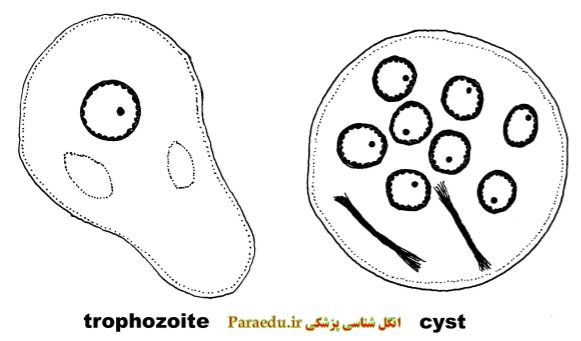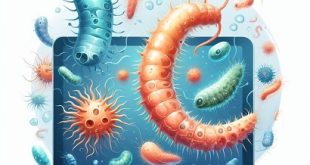انتامبا کلی یک گونه غیر بیماری زا از آمیب ها ست که می تواند در روده بزرگ انسان زندگی کند. در طول چرخه زندگی خود دارای سه شکل مورفولوژیکی متمایز است: تروفوزوئیت، پرکیست و کیست. در این مطلب مورفولوژی هر فرم را به تفصیل توضیح خواهیم داد.
مورفولوژی انتامبا کولی
تروفوزوئیت
تروفوزوئیت مرحله فعال انتامبا کلی است که توانایی تغذیه هم دارد. معمولاً در مجرای روده بزرگ یافت می شود، جایی که از باکتری ها و سایر مواد زائد تغذیه می کند.
- تروفوزوئیت گرد یا بیضی شکل است و قطر آن ۱۵ تا ۵۰ میکرومتر است.(در بعضی منابع تا ۶۰ میکرون هم گفته شده)
- دارای یک هسته بزرگ با غشای ضخیم است.
- هسته حاوی تعداد زیادی گرانول کروماتین و یک کاریوزوم بزرگ و نامنظم است. کاریوزوم اغلب به صورت غیرعادی در هسته قرار دارد.
- سیتوپلاسم تروفوزوئیت دانه ای است و حاوی واکوئل های غذایی است.
- تروفوزوئیت با گسترش پاهای کاذب حرکت می کند، اما حرکت آن آهسته و غیر پیشرونده است.

پره سیست (پره کیست)
پره کیست مرحله انتقالی بین تروفوزوئیت و کیست است. هنگامی که تروفوزوئیت تغذیه خود را متوقف می کند تشکیل می شود. پرکیست کوچکتر از تروفوزوئیت است و ۱۰ تا ۲۰ میکرومتر قطر دارد. دارای یک هسته با غشای ضخیم است. هسته حاوی گرانول های کروماتین کمتر و کاریوزوم کوچکتر و فشرده تر است. سیتوپلاسم پره کیست شفاف و حاوی واکوئل های گلیکوژن است. پره کیست یک دیواره نازک کیست در اطراف خود ایجاد می کند و برای تشکیل کیست تحت تقسیم هسته ای قرار می گیرد.
از آنجایی که این مرحله، یک مرحله انتقالی و گذرا است، معمولاً کمتر مشاهده می شود.
کیست انتامبا کولی
کیست مرحله عفونی و مقاوم انتامبا کلی است. از طریق مدفوع دفع می شود و می تواند ماه ها در محیط خارجی زنده بماند.
- کیست کروی یا کمی بیضی شکل است و ۱۰ تا ۳۵ میکرومتر قطر دارد.
- دارای دیواره ضخیم، صاف است.
- کیست بسته به مرحله آن دارای یک تا هشت هسته است.
- هسته ها دارای غشای نازک و مقدار کمی کروماتین هستند. کاریوزوم کوچک است و در مرکز هسته ها قرار دارد.
- سیتوپلاسم کیست دانه ای است و حاوی اجسام کروماتوئید و واکوئل های گلیکوژن است.
جمع بندی
انتامبا کلی یک آمیب غیر بیماری زا است که دارای سه شکل مورفولوژیکی تروفوزوئیت، پرکیست و کیست است. تروفوزوئیت مرحله فعال و تغذیه، پره کیست مرحله انتقالی و کیست مرحله عفونی و مقاوم است. مورفولوژی هر فرم با اندازه، شکل، هسته، سیتوپلاسم و دیواره کیست انگل مشخص می شود.

لینک دانلود اسلایدهای انتامبا کولی
پیشنهاد مطالعه بیشتر:
Entamoeba coli morphology
Entamoeba coli is a non-pathogenic species of amoeba that can live in the human large intestine. It has three distinct morphological forms during its life cycle: trophozoite, precyst, and cyst. In this article, we will explain the morphology of each form in detail.
Trophozoite
The trophozoite is the active and feeding stage of Entamoeba coli. It is usually found in the lumen of the large intestine, where it feeds on bacteria and other debris. The trophozoite is round or oval in shape and measures 15 to 50 micrometers in diameter. It has a single large nucleus with a thick membrane. The nucleus contains many chromatin granules and a large, irregular-shaped karyosome. The karyosome is often eccentrically located in the nucleus.
The cytoplasm of the trophozoite is granular and contains food vacuoles and sometimes ingested red blood cells. The trophozoite moves by extending pseudopods, but its movement is slow and non-progressive. The trophozoite can divide by binary fission to produce more trophozoites, or it can encyst to form a precyst.
Precyst
The precyst is the transitional stage between the trophozoite and the cyst. It is formed when the trophozoite stops feeding and rounds up. The precyst is smaller than the trophozoite and measures 10 to 20 micrometers in diameter. It has a single nucleus with a thick membrane. The nucleus contains fewer chromatin granules and a smaller, more compact karyosome. The cytoplasm of the precyst is clear and contains glycogen vacuoles. The precyst develops a thin cyst wall around itself and undergoes nuclear division to form a cyst.
Cyst
The cyst is the infective and resistant stage of Entamoeba coli. It is passed in the feces and can survive for months in the external environment. The cyst is spherical or slightly oval in shape and measures 10 to 35 micrometers in diameter. It has a thick, smooth, and refractile cyst wall. The cyst contains one to eight nuclei, depending on the stage of maturation. The nuclei have a thin membrane and a small amount of chromatin. The karyosome is small and centrally located in the nuclei. The cytoplasm of the cyst is granular and contains chromatoid bodies and glycogen vacuoles. The cyst is ingested by a new host and excysts in the small intestine, releasing trophozoites.
Summary
Entamoeba coli is a non-pathogenic amoeba that has three morphological forms: trophozoite, precyst, and cyst. The trophozoite is the active and feeding stage, the precyst is the transitional stage, and the cyst is the infective and resistant stage. The morphology of each form is characterized by the size, shape, nucleus, cytoplasm, and cyst wall of the parasite.
 انگل شناسی پزشکی Medical Parasitology
انگل شناسی پزشکی Medical Parasitology





